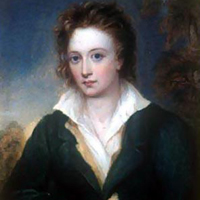Adonais by Percy Bysshe Shelley: Summary and Critical Analysis
Adonais is a pastoral elegy which Shelley wrote on the death of his contemporary poet John Keats. Like Milton's 'Lycidas', it is an English adaptation of the classical form of elegy perfected by poets as early as the classical Greek times of Homer and Virgil. 'Adonais' is written mainly in the classical pattern, though Shelley has adapted and added some of the elements.

P. B. Shelley (1792-1822)
The setting is dramatic, and the reader feels as if someone just struck by sorrow is frantically running around calling everyone to mourn; but the actions and shifts in time and place are to be guessed from the subtle clues in the poem. This pastoral elegy is written in the pattern of the classical pastoral elegy.
It begins with an invocation and mournful tone; then it describes the nature’s participation in the bereaved shepherds/poets’ mourning for the deceased one; there follows a procession of mourners (among them are Shelley himself and Lord Byron); then the speaker attacks on the worst literary critics who damaged the self-esteem and honor of the growing artist Keats, before moving to the consolation as a conclusion. But Shelley has invented his own type of coda: he has expressed his transcendental concept of death and his own foreboding of death at the end of the poem.
The mood gradually shifts from grief to comfort as the poem approaches its end. Shelley makes Keats spirit one with the Eternal; after viewing the Protestant Cemetery in Rome, Shelley presents his philosophic concept related to Plato’s doctrine of the ideal: Life, like a dome of many colored glasses. Shelley claims, with reference to his Neo-Platonic ideals, that Keats death in glory is far better than the inglorious and shameful life of his murderer, the savage critic. He also feels that he is being called by the spirit of John Keats in the immortal world: in fact, Shelley died after about two years of Keats death!
The name ‘Adonais’ comes from two sources (Adonis and Adonai) one classical and the other Christian. Adonis in Greek mythology is a beautiful mortal youth beloved by the two goddesses Aphrodite and Proserpine. After being slain by a wild boar while hunting, he was restored by the god Zeus for Aphrodite, but since he was kept for so long by Proserpine, Zeus decreed that Adonis should spend the winter months with Persephone in Hades and the summer months with Aphrodite. The story of his death and resurrection is symbolic of the natural cycle of death and rebirth. On the other hand, the name ‘Adonai is etymologically related to ‘add-on’, a Semitic word meaning “lord” that occurs in the Old Testament. In Shelley’s poem, the word, while representing Keats literally, also suggests the natural rebirth of the immortal poet, as also the divinely creative (lord’s) power of the poet. Besides, Uriana is in Shelley’s conception, both Aphrodite, the earth-mother of Adonis myth, and the spiritual influence which Milton invoked as ‘heavenly muse’.
Indeed, it may seem strange that Shelley should choose to lament Keats death in such an artificial and constrained format as the pastoral requires. If his feelings of grief were genuine, one might ask, why not have expressed them in plain, or at least far less contrived terms. The pastoral allows the poet to exercise, nevertheless, the option of poeticizing the event. From that perspective, Shelley, who was quite capable of using a wide range of poetic styles and expression, was first of all doing his fellow poet a high honor by eulogizing him in a structure unique to poetic discourse.
Shelley adheres to all the traditional formal pastoral constraints -and more- in producing his elegy. In keeping with the tradition, he does not identify the characters by their actual names, but by their shepherd names or by characteristics typical of natural rather than the social environs. Since the tradition is Greek, he harks back to classical myth and imagery. Keats poetic efforts, as noted previously, are his flocks. The procession of mourners is appropriately arrayed with flowers and other vestiges of spring; even in the depths of his grief, the poet never fails to remind the reader that it is in fact the springtime of the year.
The elegiac pastoral is compelled to render the experience positive by the end of the poem, for while no poet can deny the undeniable reality of bodily death, the pastoral’s very idealizations require one to imagine a transcendent reality as the true locus of all human hopes and aspirations. In its spirited exultation that light shall triumph over darkness, that the truth shall endure the violence done them through hatred and spite, resurrections that can take the breath away, Adonais reaffirms life in the very act of lamenting an individual’s death.
Cite this Page!
Sharma, K.N. "Adonais by Percy Bysshe Shelley: Summary and Critical Analysis." BachelorandMaster, 27 Nov. 2013, bachelorandmaster.com/britishandamericanpoetry/adonais.html.
